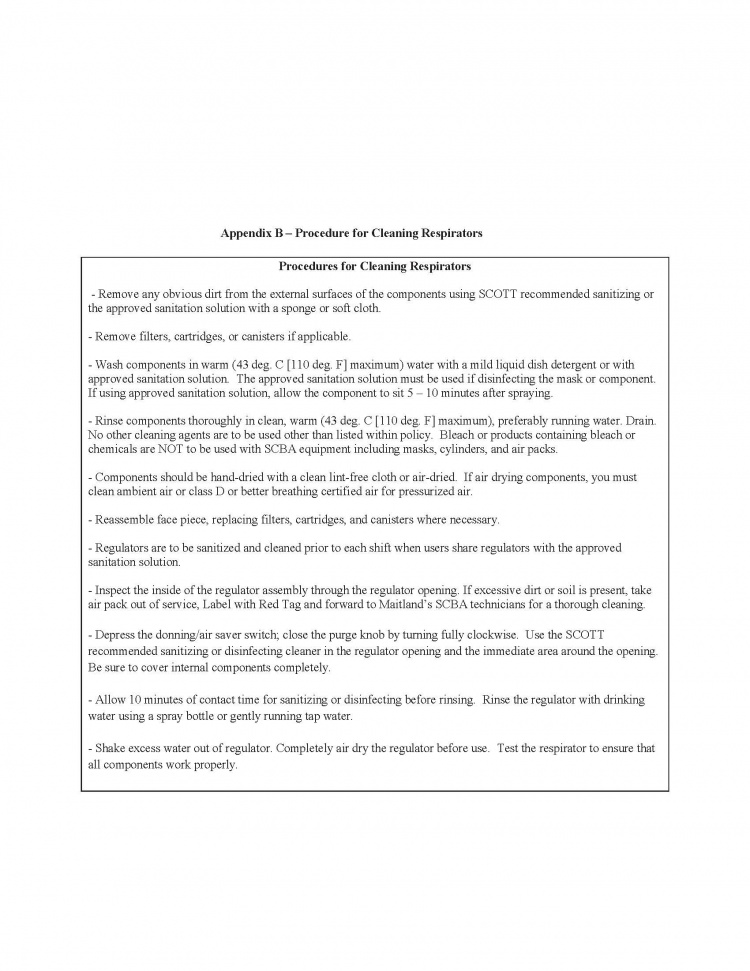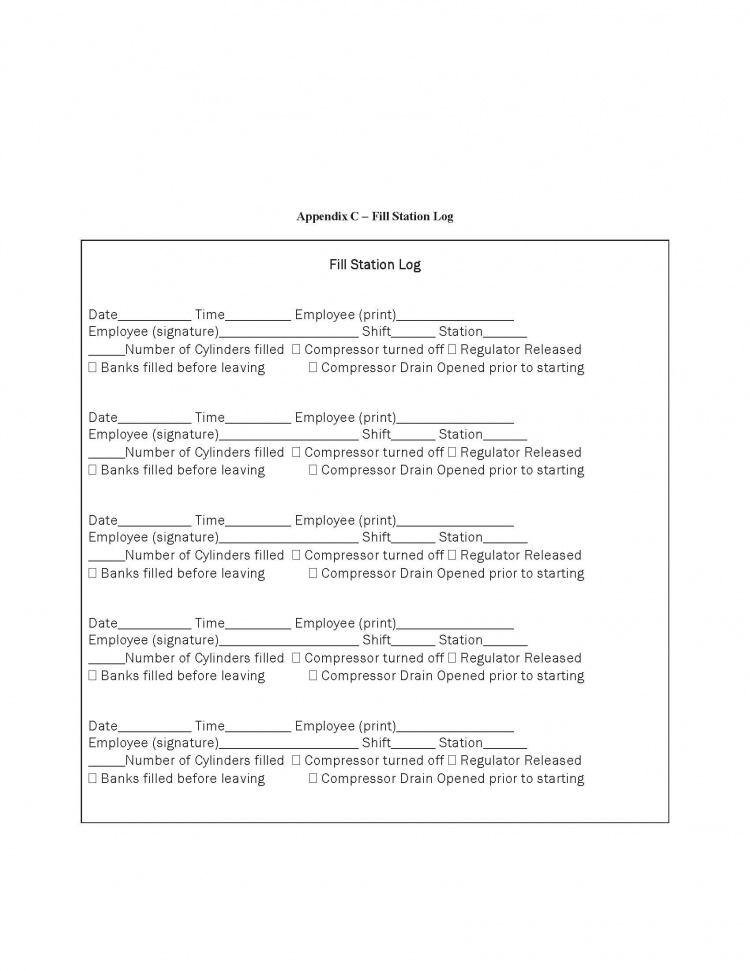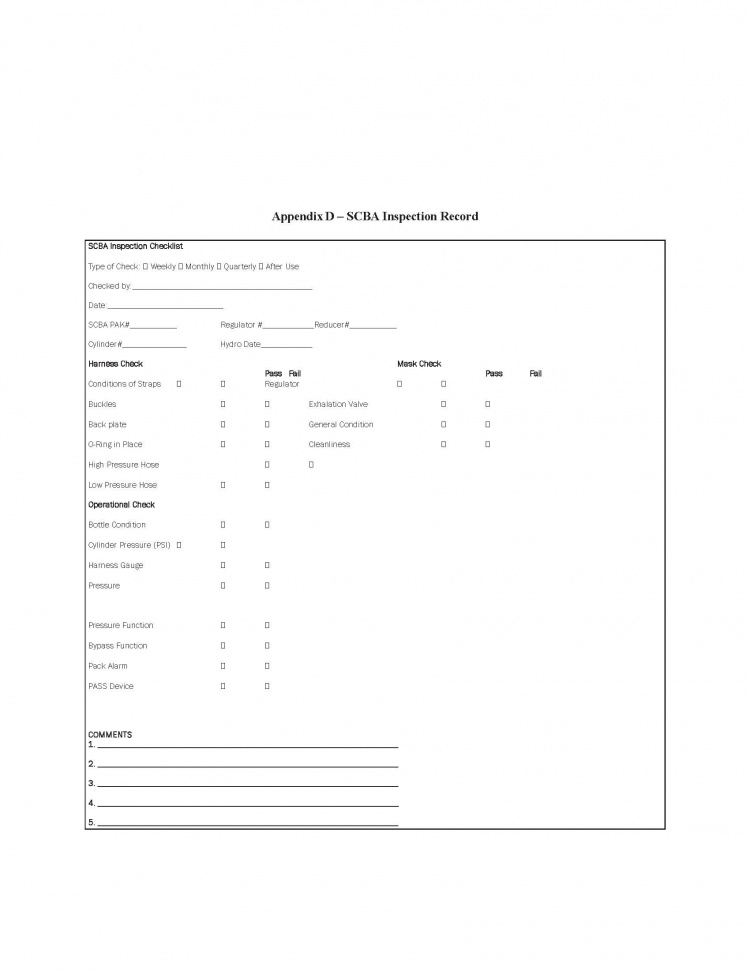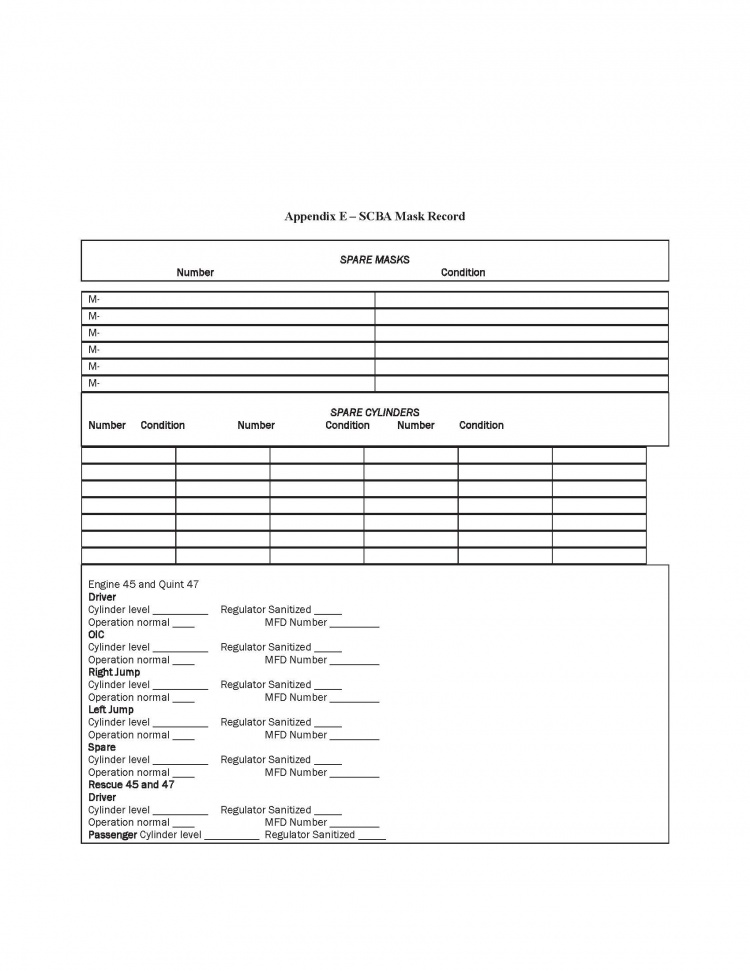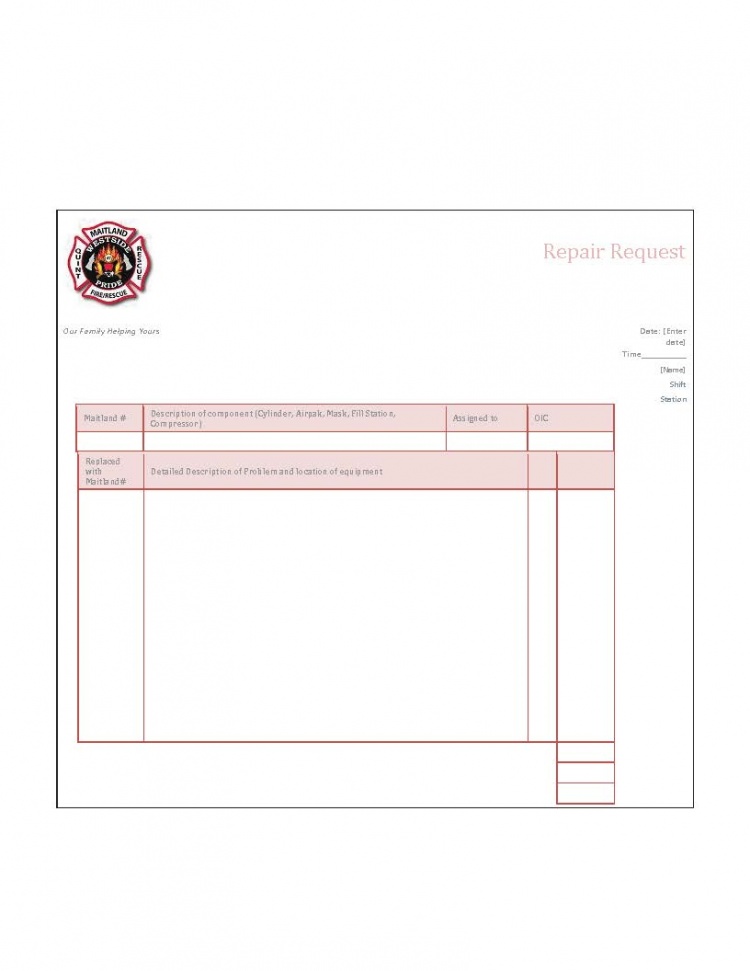Difference between revisions of "SCBA Repair & Maintenance"
Mfrdmanager (talk | contribs) (→PROGRAM EVALUATION) |
Mfrdmanager (talk | contribs) (→PROGRAM EVALUATION) |
||
| Line 123: | Line 123: | ||
[[File:scba5.jpg|750px|]] | [[File:scba5.jpg|750px|]] | ||
[[File:scba6.jpg|750px|]] | [[File:scba6.jpg|750px|]] | ||
| + | [[File:scba7.jpg|750px|]] | ||
[[Category:Fire Operations - Facilities and Equipment]] | [[Category:Fire Operations - Facilities and Equipment]] | ||
Revision as of 12:32, 15 May 2016
Contents
Section 2 - EMERGENCY OPERATIONS
250.06 SCBA Repair & Maintenance
PURPOSE:
To established a guideline for the care and maintenance of personal protective equipment for structural firefighting.
The following guideline is established to provide a program for the proper selection of Self Contained Breathing Apparatus elements used by this organization for respiratory protection and the intent is to minimize the safety and health risks associated with
poorly maintained, contaminated or damaged protective equipment.
The established guideline shall comply with NFPA 1851, the Standard on Selection, Care and Maintenance of Structural Fire Fighting Protective Ensembles, 2014 edition. The manufacturer requirements of the protective ensembles shall also be reviewed.
PROCEDURE:
Administration and Guidelines
- Selection Committee:
- The Department’s designated Safety Committee shall oversee the authorization/selection of structural firefighting ensemble. The Assistant Fire Chief or his/her designee will be responsible for the care, maintenance and record keeping of the Department’s personal protective equipment.
- Contract Resources
- If this organization elects to utilize contract resources for specific parts of this program, the contractor shall substantiate to the committee that it has been recognized by the manufacturer to perform:
- Testing
- Repair
- Warranty work
- Modifications
- The contractor shall also identify limitations placed by the manufacturer as a condition of recognition.
- If this organization elects to utilize contract resources for specific parts of this program, the contractor shall substantiate to the committee that it has been recognized by the manufacturer to perform:
- Inventory
- All SCBA inventory is assigned to specific locations including vehicles or personnel.
TRAINING
- Firefighters wearing respiratory protection shall be trained in proper use, cleaning and maintenance. No firefighter shall wear respiratory protection without training as specified in this document. Training in the use of respiratory protection shall be done in two phases. Each new firefighter will be given initial training before using respiratory protection and annual training thereafter.
- New Recruit Training - Initial training is to be provided during the Fire Fighter I Course at a State approved training academy. No firefighter is to use respiratory protection unless training has been successfully completed. Firefighters trained at other than a state approved fire academy must be certified as trained by the Safety Officer or designees before wearing an SCBA.
- Annual Training - On-going training shall be provided to all firefighters of the Department. Each firefighter must pass a face piece fit-test during initial and annual training. Appendix B of this program contains the fit-test protocol and example fit-test record. At a minimum, the following topics are to be covered in the SCBA training.
- Why the SCBA is necessary and how improper fit, usage, or maintenance can compromise the protective effect of the respirator.
- What the limitations and capabilities of the SCBA are.
- How to use the SCBA effectively in emergency situations, including situations where the SCBA malfunctions.
- Instruction on recognizing medical signs and symptoms that may limit or prevent the effective use of the SCBA.
- How to inspect, put on and remove, use, and check the seals of the SCBA.
- What the procedures are for maintenance, and storage of the SCBA.
- The general requirements of the Respiratory Protection Standard.
- Fill Station Training - SCBA cylinders will be filled only by firefighters who have completed fill station training. Retraining will be provided annually. Initial and annual fill station training shall include:
- Procedures for inspecting the SCBA cylinder for damage.
- Information to ensure that the cylinder has the proper hydrostatic test date.
- Information to ensure that composite cylinders older than 15 years are not refilled and are removed from service.
- Procedures for safely operating the fill station.
- Information on the importance of using at least grade D air.
- Information on the consequences of cylinder failure.
- The manufacturer’s instructions for the fill station.
- Record keeping requirements, Cascade Fill Station Log.
- Non IDLH Training Only Air packs - Air packs will be available for all non- IDLH training. These air packs will be identified as such by the fluorescent paint on the backpack frame.
Any employee wanting to check out an air pack for outside department demonstrations or training evolution in a “Non IDLH” environment, can do so by requesting permission from Fire Administration via email. An SCBA technician will assign a pack for the event. Training air packs will be used for outside department demonstrations.
RESPIRATOR FITTING AND SEAL CHECK
Each firefighter must pass a face piece fit-test during initial and annual training.
- Inspection Before Use - When using SCBA, each firefighter shall select and wear the correct size face piece as determined by initial and annual fit testing. A firefighter shall not wear respiratory protection unless the proper size face piece is available and the equipment is in proper working condition according to the manufacturer’s specifications.
- Effective Seal Required - An effective face-to-face piece seal is extremely important when using respiratory protective equipment. Minor leakage can allow contaminants to enter the face piece, even with a positive pressure SCBA. Any outward leakage will increase the rate of air consumption, reducing the time available for use and safe exit. The face piece must seal tightly against the skin, without penetration or interference by any protective clothing or other equipment.
Nothing can be between the sealing surface of the mask and the face of the wearer, including but not limited to, eyeglasses, protective hoods, and beards or other facial hair.
Firefighters shall perform a seal check prior to every SCBA use. SCBA can only be worn when an adequate seal is achieved. (NOTE: the required seal check procedures are found in Appendix B-1 of the Respiratory Protection Standard.
INSPECTION, STORAGE, MAINTENANCE AND AIR SUPPLY
- Inspection - Regular periodic inspections are required to ensure that all respiratory protection equipment is properly operating and available for use. Inspection Schedule
- All SCBA and spare cylinders shall be inspected before and after each use and at least monthly. Guidelines for inspection are in the manufacturer’s instructions and NFPA 1852 is found in Appendix A of this program.
- After each inspection, the appropriate forms (see Appendix E) shall be completed. SCBA units determined to be unfit for use shall be taken out of service, and “RED” tagged and a repair request form filled out and emailed to the SCBA Repair Team, see Section 8 Repair Request.
- In the event replacement or repair of SCBA components is necessary, it shall be performed according to manufacturer’s instructions and only by persons trained and certified by the manufacturer or returned to a certified service facility.
- Firefighters will not subject SCBA units to unnecessary abuse due to neglect and/or carelessness. Caution must especially be exercised to protect the face piece section of the mask from being scratched or damaged. Each Firefighter has been issued a fleece lined, mask bag for storage, when not in use.
- Each SCBA shall be cleaned and disinfected after each use. Only cleaning/sanitizing solutions for respiratory equipment will be used for cleaning and disinfection. (NOTE: the required SCBA cleaning procedures are found in Appendix B-2 of the Respiratory Protection Standard.
- SCBA cylinders shall be hydrostatically tested within the period specified by the manufacturer and applicable governmental agencies. Composite cylinders must be tested every five (5) years. Composite cylinders will be removed from service after 15 years from the first hydrostatic test date.
- Storage - All units shall be stored so that they are protected against direct sunlight, dust accumulation, severe temperature changes, excessive moisture, fumes, and damaging chemicals. Care is to be taken so that the means of storage does not distort or damage rubber or elastomeric components.
- Air Supply - Breathing air in the SCBA cylinder shall meet the requirements of the Compressed Gas Association G-7.1-‘13, COMMODITY SPECIFICATION FOR AIR, with a minimum air quality of Grade D. The Fire Department shall ensure that private vendors supplying compressed breathing air provide a copy of the most recent inspection and certification.
- Records of testing will be maintained digitally in the database management software and a hard copy file. The results of the quarterly testing will be posted at both the fill station and the compressor as required by NFPA and CGA.
- The purity of the air from the Fire Department’s air compressor shall be checked by a competent laboratory quarterly.
- The Fire Department shall assure that sufficient quantities of compressed air are available to refill SCBA for all emergencies. In the event that the department’s air compressor is out of service than this can be accomplished through mutual aid with Winter Park or Orange County Fire Department.
- Air cylinders for SCBA shall be filled only by personnel who have completed fill station training. Compressed oxygen shall not be used in open-circuit SCBA.
TESTING
The following tests will be completed either by a certified contractor or department certified SCBA technicians:
- Mask fit tests will be complete annually on every combat firefighter
- SCBA flow test will be complete annually on every in-service SCBA air pack
- Cascade air quality tests will be complete quarterly
MEDICAL EVALUATION
A medical evaluation to determine the firefighter’s ability to wear a SCBA will be provided. Only firefighters that are medically able to wear SCBA will be allowed to do so.
RECORDKEEPING
- The SCBA repair program manager will maintain the following reports:
- Completed SCBA inspection forms
- Air quality tests records/results
- Completed fit test records for each combat firefighter
- SCBA training records
- Fill station training records
- Inventory information will be stored in the Fire Program database and backed-up on USB drive. Each inventory component will have a hard paper file containing maintenance, inspection and location information. These records will be kept in the SCBA Repair Room.
- The information for each unit must include:
- Date the unit was first placed in service.
- Dates for required inspections along with name of the person who conducted the inspection.
- Dates for each use of the SCBA — training exercise or fire incident, along with the name of the user.
- Information regarding repairs to unit and manufacturer upgrades, etc.
- Date the unit was permanently removed from service.
- The information for each unit must include:
REPAIR REQUEST
- SCBA Repair Procedures - Department personnel must be able to identify those repairs to an SCBA unit that they can make and the signs that indicate an SCBA should be removed from service and examined by a certified technician.
- Personnel will follow the manufacturer's recommendations that are included in the operational manual, online at the manufacturer's website, and in the department's initial and annual training on the unit. All issues shall first be reported to OIC and/or Battalion Chief as directed by current SOP’s.
- SCBA Repair Team - The technician receiving the equipment will fill out the bottom of the repair request form.
- When the unit returns from being repaired, include the following information before putting the unit back in service:
- Date and time unit was received.
- Description of the repairs made to the unit, the name of the technician who worked on the unit, and the name of the company that employs the technician.
- Inspection of the unit to ensure that the necessary repairs have been made and that the unit is now functioning properly.
- Date and time unit was placed back in service.
- When the unit returns from being repaired, include the following information before putting the unit back in service:
The person responsible for conducting the inspection/repair on the SCBA will be responsible for documenting that the inspection was completed as required.
PROGRAM EVALUATION
- Evaluation Requirements - The effectiveness of the SCBA program shall be evaluated and corrective actions taken to ensure the respiratory protection program is properly implemented. The fire department will regularly consult with firefighters to assess their views on the effectiveness of the program and to identify any problems. The evaluation will ensure:
- Procedures for purchasing of approved equipment are in place;
- All firefighters are being properly fitted with respiratory protection;
- All firefighters are properly trained;
- The proper equipment, cleaning, inspection, and maintenance procedures are implemented;
- The required records are being kept;
- Changes are implemented to correct deficiencies.
- Program Monitoring - Periodic monitoring of the respiratory protection program is necessary to ensure that all firefighters are adequately protected. Random inspections shall be made by the Assistant Fire Chief or designee to ensure that the provisions of the program are being properly implemented.

